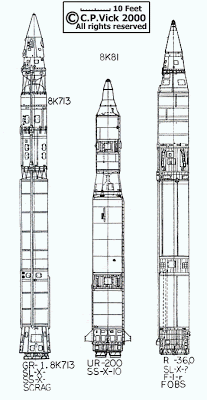
The Fractional Orbital Bombardment System (FOBS) was a Soviet weapons program that started in the 1960s whose goal was to develop a nuclear capable ICBM vehicle which would, once launched, inject into LEO (Low Earth Orbit) upon which the payload could de-orbit and strike a ground target. Basically it turns out that launching a nuclear weapon from space is highly effective and that many long-range defenses are thus automatically bypassed
The Soviet-era FOBS program caused so much panic and concern in the west at the time that the Outer Space Treaty of 1967 was drafted, which led to the FOBS program being decommissioned, the treaty has banned the use of nuclear capable weapons in earth orbit since then. However it can be argued that many of the parties that originally signed this treaty could have already secretly developed similar programs and could thus potentially use these arcane programs against Russia in the future. Not even mentioning all the numerous, on-going violations of many non-proliferation treaties by other countries. Russia in my opinion, shouldn't be reducing its nuclear stockpile or nuclear capabilities, it should be increasing them for the sake of deterrence or even MAD. I therefore propose that the Russian strategic nuclear forces reconsider a nuclear deterrence system similar to FOBS for deployment.
However if a program such as FOBS is to be reconsidered drastic design reconsideration of the payload launcher vehicle must be taken into account. Firstly the payload launcher vehicle should be permanently stationed in orbit until a launch is initiated instead of launching the vehicle into orbit shortly before an attack and waiting for the payload to de-orbit, this means that it would take substantially longer for any early warning satellite satellite system to detect an imminent nuclear strike due to the suppression of ground based thermal or IR signatures. The launcher vehicle should then ideally inject into LEO and hold when the weapon is initiated.
Secondly we must take into account the realities of ABM systems. Once a warhead is detected and a ABM originating projectile is launched, first strike uncertainty is increased. ABM systems, however, rely on sensor inputs to guide ABM originating projectiles to their target, EM/IR sensor/transducer resolution, however, can theoretically be reduced by increasing radiation/EM flux density uniformly within a given volume in space, making distinguishing a target much more difficult if not impossible. What this means, assuming a large enough yield, is if a launch is initiated, one of the many reentry vehicles would need to be detonated sequentially after launch, to provide this increase in energy density and subsequently, decrease in sensor resolution along the target pathway. This is repeated until the main attack vehicles reach a suitable distance above earth's atmosphere. Thus the travel trajectory of the main attack vehicle's should then ideally transverse these spherical blast volumes, making target identification to the ABM system practically impossible, in theory.
Once the final RV's are close to reentry they separate drastically, by this time no ABM system would be able to cope with the speed and number of re-entry vehicles and even in the best case scenario, assuming 100% interception, the blast radius and fallout would be so severe that surviving such an attack would be impossible. Another possibility would be the addition of ozone-degenerating compounds which would destroy part of the ozone layer covering the target's land mass to increase radiation penetration. This is very hypothesized but I'm sure something similar can be done.
Having a good deterrence strategy is one of the best defenses a country can possess.



 Hole
Hole